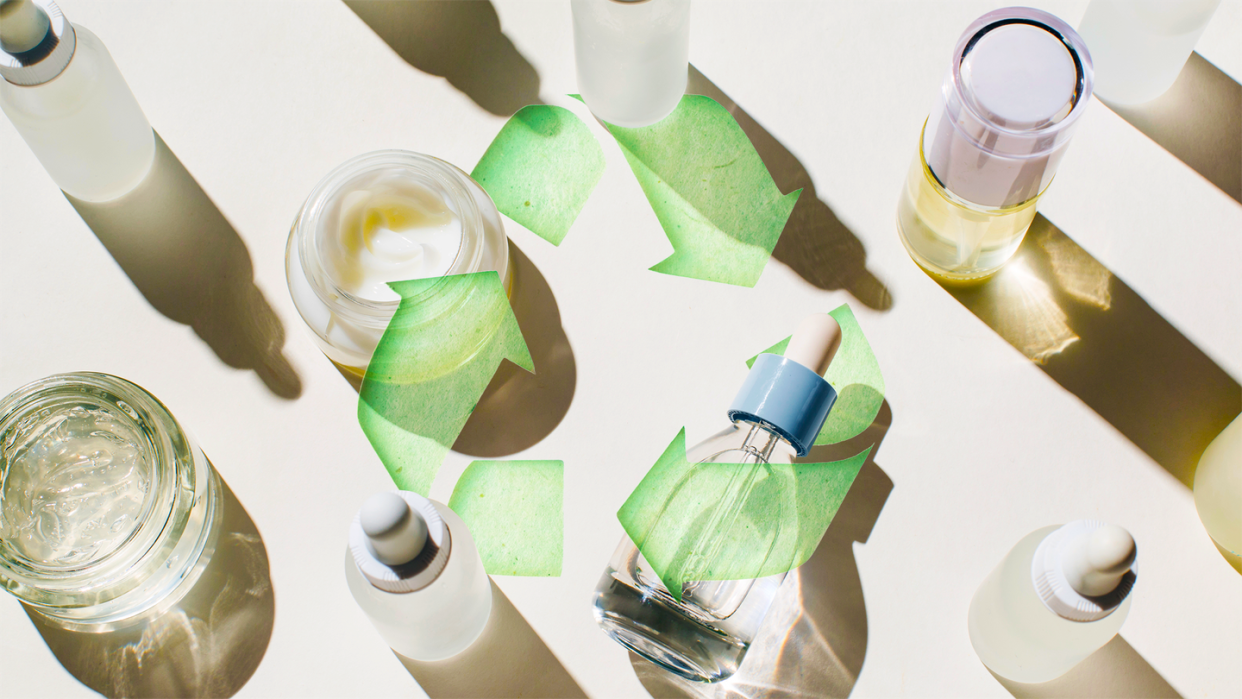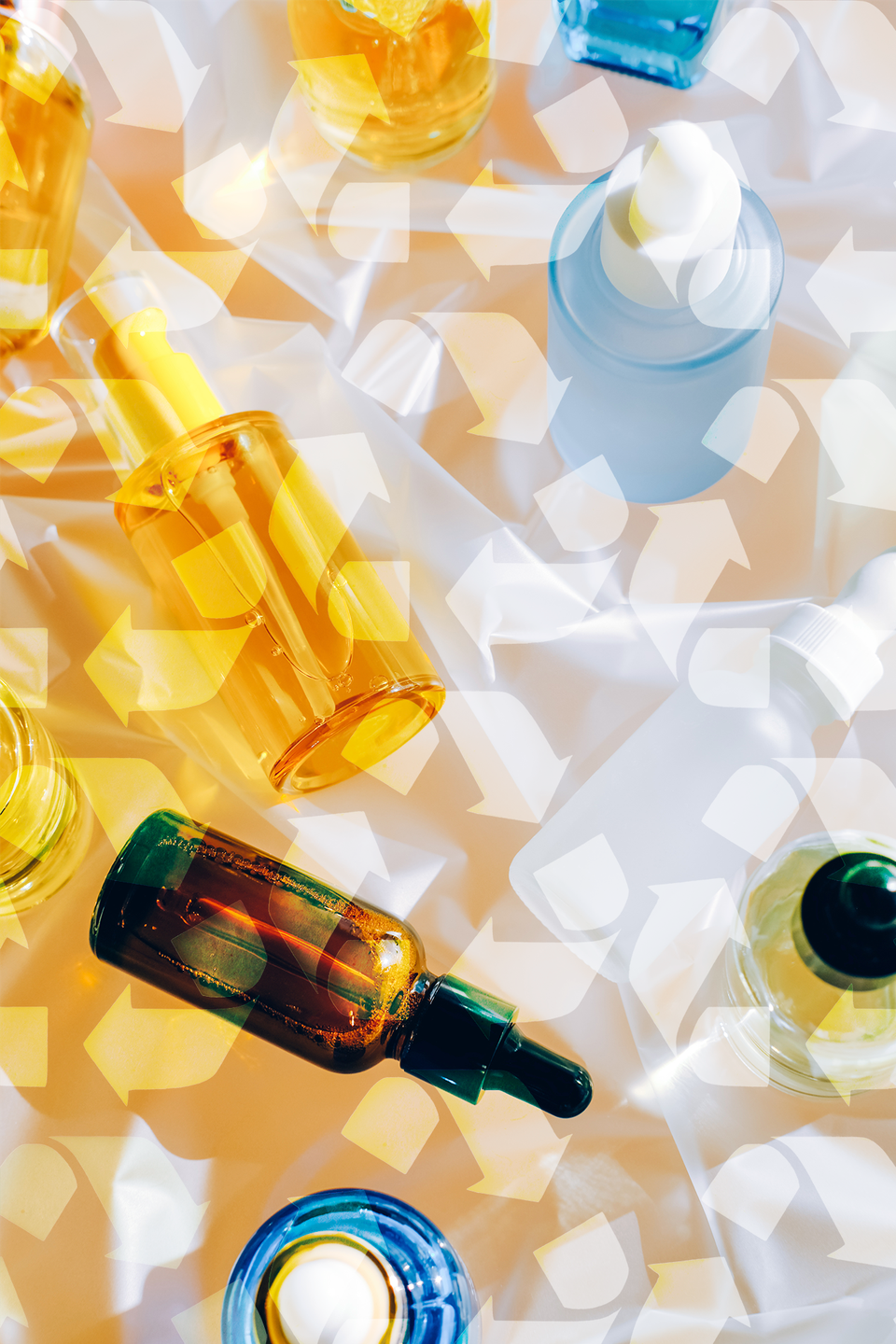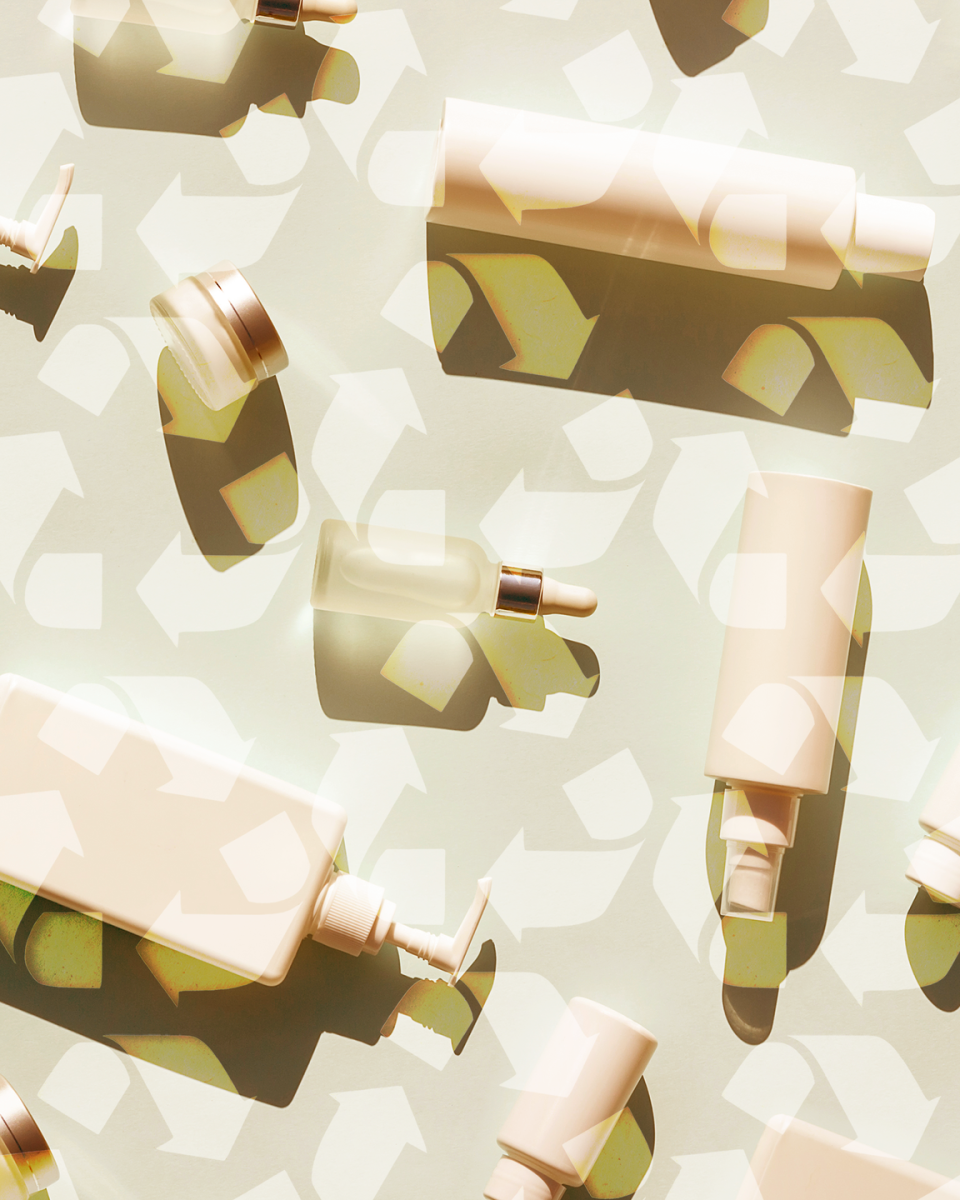Thought You Had to Toss Your Empty Beauty Containers? There May Be Another Way.

"Hearst Magazines and Yahoo may earn commission or revenue on some items through these links."
We’ve all paused over the recycling bin, inspecting every angle of a product to decide whether we can chuck it in. One reason for our uncertainty is that the “chasing arrows” symbol is notoriously confusing, so we are often left to decide on our own with minimal information to guide us. Another reason is that municipal, or curbside, recycling programs accept only limited materials — glass, metal and certain plastics — and we’re all dealing with our municipalities because there is no federal recycling law.
Things become particularly confusing when we’re faced with beauty products like lipstick tubes or lotion pumps, which are frequently made from multiple materials. Beauty packaging is also often quite small, which can pose challenges to disposing of it and having it arrive in large enough pieces to properly sort it. According to a 2022 report from the Ellen MacAurthur Foundation, even though the beauty industry as a whole is moving toward packaging that is “more recyclable,” 62% of it is still non-recyclable. And this is layered onto the fact that, as a nation, we’re not recycling all that much anyway: We fall below Europe and Australia, as a comparison.
The Good Housekeeping Institute has been pursuing sustainable solutions in the beauty realm for years. The first iteration of our Sustainable Innovation Awards was focused on packaging due to the concerns over the impact of personal-care waste on the environment, and we have only broadened the awards program to find the most responsible companies.
To further our commitment to learning, Good Housekeeping’s former Executive Director of the Beauty, Health and Sustainability Lab, Birnur Aral, Ph.D., recently visited a recycling plant that partners with TerraCycle, one of the leading private recycling companies in the U.S. She also spoke with Tom Szaky, TerraCycle’s CEO, who shared how the industry is partnering with brands and home consumers to tackle the waste issues we face.

What are private recycling companies, and how are they helping?
Private commercial recycling companies like TerraCycle work by collecting waste that is not accepted by curbside bin programs. TerraCycle, specifically, finds processing plants that will recycle a wider array of materials so that less waste goes to landfills.
“Recycling is urban mining,” says Szaky, who believes that many materials could be recycled if they were considered valuable. “If all beauty products were packaged in solid gold, there would be no issue.”
So the goal is to make a broader swath of packaging, particularly more types of plastics, worth the effort to recycle or reuse. Fortunately, more and more companies are seeing the imperative of having a plan for the end of their products’ lives, and they’re willing to pay private recyclers to communicate to customers that they are a responsible business.
Big brands, retailers and salons partner with TerraCycle to offer collection bins, and then the businesses pay to get the waste to and recycled by TerraCycle.
Video: TerraCycle
TerraCycle’s first partnership in the beauty category was with Garnier back in 2009. The major beauty brand offered a takeback program for its own bottles as well as any personal care and cosmetic waste that was not curbside recyclable. Thanks to TerraCycle’s practice of washing and drying the empty bottles — so the consumer doesn’t have to, as they should with municipal recycling — the program caught on and is now offered by high-end brands like Yves Saint Laurent and drugstore mainstays like Head and Shoulders, Nordstrom’s Beautycycle program includes collection boxes that accept all brands of beauty waste, and there are drop-off points for items like contact lenses through Bausch + Lomb’s One by One Free Recycling Program, which accepts all brands of contacts and blister packs.
Part of the reason brands want to work with TerraCycle is its claim that it will ensure that the packaging gets recycled. This is a guarantee that curbside recycling can’t make: Municipal plants can’t control what is sent their way, and they aren’t as diverse in their processing abilities. TerraCycle maintains a chain of custody over all the materials it receives and sends to recycling partners. It has even undergone a third-party audit to ensure the items sent will be recycled.
What can consumers do to help?
Consumers are the first step in the process in more ways than one: We all vote with our dollars. So if we buy products that are easy to refill or recycle via curbside programs, we’ve given a boost to that part of the system and created a demand for recyclable materials. But because many products currently still contain harder-to-recycle elements, we can further help by using products completely, rinsing the containers and sorting materials before they enter the recycling stream. This includes a deeper sorting of multi-material pieces — such as separating the metal spring from a plastic pump, like you might find in a lotion bottle.
We can also purchase TerraCycle's Zero Waste Pouches and Zero Waste Boxes in many sizes and specializations (such as for coffee pods or snack wrappers). Consumers pay for a clearly labeled collection pouch — like the beauty packaging Zero Waste Pouch — that is then sent back to TerraCycle. The pouches are available nationwide, and the cost of shipping and recycling all of the compliant waste is baked into the price, so it’s an easy fill-and-drop once you have it. (Very limited regions — Burlington, VT; the Denver area and the Philadelphia/New Jersey region — currently have access to TerraCycle Pick-Up, which partners with regional waste management companies; you can click “Get Started” and check your zip code if you’re in those zones.)
These types of pouches can help normalize recycling throughout the home. “I think bathroom recycling is one of the worst [areas],” says Szaky, “because we don’t put recycling bins in there like we do in our kitchen.” But stashing a bag near your vanity can go a long way toward reducing waste destined for landfills.
What happens to items sent in through private recycling programs?
TerraCycle and programs like it, such as Pact and Ridwell (which is currently available only in limited larger cities), aggregate similar items, meaning they add your contact lenses or toothpaste tubes to others in the same category, and warehouse them until it’s environmentally and financially efficient to ship them to the proper processor.
Depending on the item and the processor, the item might be washed (meaning that, for some items, the consumer won’t have to meticulously rinse it), then chopped and recycled. But, generally speaking, empty plastic items become plastic pellets. These pellets generally do not get a second life as beauty-product packaging but instead are mixed with other materials that are then used to create items like pipes, decking and outdoor furniture.
Metal recycling is a smaller piece of the puzzle with beauty items, but metals and aluminum are shredded and smelted into metal sheeting or other forms. Glass containers are crushed and melted. Clear glass can then be used to make new glass containers. Colored glass is often reused in brick, cement or concrete.
What’s the future of recycling?
Szaky says that his company is keeping a close eye on legislation in California that “outlaws manufacturers and others from selling products or packaging labeled as recyclable unless the items are regularly collected and processed for recycling in the state.” Sometimes state laws have a broader effect on national practices, so this legislation could be an indicator of the direction the industry will take.
Szaky says he’s also noticing an increase in concentrated products. This tactic, also called “lightweighting,” reduces the amount of packaging needed per product as well as the energy needed to ship it.
But TerraCycle’s Loop program is making the biggest leap into the future of production: It’s working to move from a "create > use > dispose" model of packaging to a refill system that reduces waste. The program states that it works with “brands, retailers and manufacturers to enable the sale and collection of reusable and returnable versions of conventional single-use products….” Think of it as the new version of the milkman model: You buy a product in a reusable container that is cleaned and refilled with that same type of product.
“When you think about a package, you have to think about what happens at the end of its life,” says Szaky. “What happens at the end is important because if that material is disposed of, you have to make that object again from scratch. And the biggest impact on our planet is the act of creating things.”

The takeaway
The simplest piece of advice is to think before you shop: Do you need it? If so, is there a better packaging option? And if you can’t find a better packaging option, can you start a little habit in your home to bag up and return anything that isn’t curbside recyclable?
It’s also helpful to consider which brands and retailers have collection spots — particularly brand-agnostic spots — so you have the option of dropping your clean and empty items when you stop by (or make a trip solely to stop by!).
A few popular options:
Want more help? Check out our foolproof guide to sustainable living and consider brands that earned a GH Sustainable Innovation Award.

You Might Also Like

